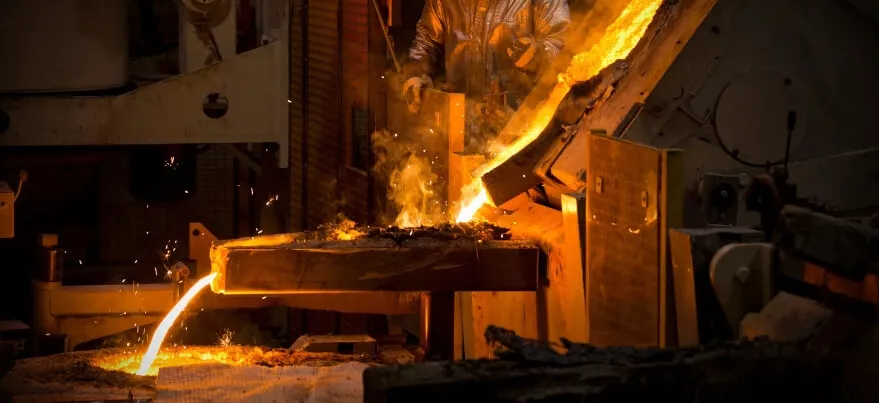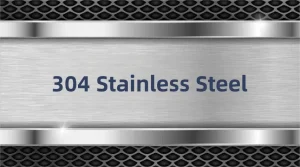Lost foam casting is commonly used for metal casting, including some complex shaped metal accessories.
In this article, we introduce lost foam casting in detail, including how it works, its advantages, and which metals can be cast using this process.
What is Lost Foam Casting?
Lost foam casting, also known as full – mold casting or evaporative pattern casting, has the following principle. It uses a foam plastic pattern instead of the traditional wooden or metal pattern. A special refractory coating is applied to the surface of the pattern. After drying, the pattern is buried in dry sand, and the mold is formed by vibrating and compacting. Then, liquid metal is poured into it.
During the casting process, the foam plastic pattern rapidly gasifies and burns away under the action of high – temperature liquid metal. The liquid metal takes the place of the original foam plastic pattern. After cooling and solidifying, the casting is formed.
The Lost Foam Casting Process
Here are the steps involved in the lost foam casting process:
1.Pattern Creation
A foam pattern (typically made of polystyrene) is created using molding or machining. The pattern should have the same shape and dimensions as the desired final casting.
2.Pattern Assembly
Multiple foam patterns can be assembled together to form complex parts. Gates, risers, and runners are attached to the pattern using adhesive.
3.Coating
The foam pattern is coated with a refractory material (such as silica or zircon) to form a thin ceramic shell. This coating helps to prevent sand infiltration and ensures a smooth surface finish.
4.Drying
The coated foam pattern is dried to remove moisture and strengthen the ceramic shell.
5.Molding
The dried pattern is placed in a flask or molding box and surrounded with unbonded sand. The sand is compacted using vibration to ensure that it fully supports the pattern.
6.Pouring
Molten metal (such as aluminum, steel, or iron) is poured into the mold. The heat from the molten metal vaporizes the foam pattern, which escapes through the coated shell and vents in the sand.
7.Cooling
The molten metal solidifies within the sand mold, taking the shape of the foam pattern.
8.Shakeout
Once the metal has cooled and solidified, the sand mold is broken away to reveal the casting.
9.Cleaning and Finishing
The casting is cleaned to remove any remaining sand, and excess material (like gates and risers) is cut off. Further finishing operations such as grinding, machining, and heat treatment may be performed.
10.Inspection
The final casting is inspected for dimensional accuracy, surface quality, and internal defects using techniques like X-ray, ultrasonic testing, or dye penetrant inspection.
Materials Used
Lost – foam casting, with its unique technological advantages, is applicable to the casting of a variety of metal materials. Here are the application characteristics of some common metal materials in lost – foam casting:
Cast Iron
Cast iron has excellent casting properties. It has good fluidity, which enables it to fill the complex cavities of foam plastic patterns well in lost – foam casting. Moreover, cast iron has a relatively small shrinkage rate, reducing the tendency of deformation and cracking of castings during solidification.
Cast Steel
Cast steel features high strength and high toughness, capable of withstanding large loads and impacts. It has good weldability, facilitating the repair and assembly of castings in the later stage.
However, due to its high melting point, cast steel requires higher pouring temperatures in lost – foam casting and better refractory properties of the coating.
Aluminum Alloy
When casting aluminum alloy by lost – foam casting, because the melting point of aluminum alloy is relatively low, the thermal effect on the foam plastic pattern is small, which is beneficial for maintaining the integrity of the pattern and reducing problems such as pattern deformation and poor gasification. Additionally, this process can produce thin – walled and complex – shaped aluminum alloy castings, improving material utilization and reducing production costs.
Copper Alloy
Lost – foam casting can accurately replicate the complex shapes and fine structures of copper alloy castings. For some electrical connectors and instrument parts with special shape requirements, it can reduce subsequent processing procedures and improve production efficiency.
Meanwhile, due to the good permeability of the mold, it is conducive to the discharge of gas in the copper alloy liquid, reducing defects such as pores and improving the quality of castings.
In addition, some special alloy materials can also be cast by lost – foam casting, such as nickel – based alloys and titanium alloys. However, due to their high melting points and strong activity, these alloy materials have more stringent requirements for the casting process and materials, and special measures need to be taken to ensure the quality of castings.
Advantages of Lost Foam Casting
Lorem ipsum dolor sit amet, consectetur adipiscing elit. Ut elit tellus, luctus nec ullamcorper mattis, pulvinar dapibus leo.
High Design Freedom
Lost – foam casting can directly fabricate foam models according to complex designs, enabling the production of castings with intricate shapes and precise structures. Since there is no need to consider the draft angle, this technology can easily cast complex structures such as internal cavities, blind holes, and curved surfaces.
Moreover, this process is highly suitable for manufacturing integrated – structure castings, effectively reducing the need for assembly and welding. This brings great convenience to production and improves both production efficiency and product quality.
Cost - Effective
Lost – foam casting reduces production costs in several ways:
Low Tooling Costs: It saves on mold manufacturing and maintenance costs, especially suitable for small – batch and customized production.
High Material Utilization: Using non – bonded sand, the sand can be recycled, reducing material consumption and production costs.
Lower Labor Costs: With one – piece molding, the number of assembled parts is reduced, saving labor and assembly expenses.
High Production Efficiency
The foam models in lost – foam casting can be produced rapidly, making it highly suitable for mass – production and automated production needs, effectively increasing production scale and efficiency. During the pouring and solidification stages of this process, there is no need to remove the model. This characteristic greatly simplifies the otherwise cumbersome casting procedures, reducing operation processes and time costs.
Additionally, multiple complex parts can be cast simultaneously in the same sand box, fully utilizing space and resources and further enhancing production efficiency, making the production process more efficient, convenient, and cost – effective.
Suitable for Diverse Materials and Casting Conditions
It is applicable to a variety of metal materials such as aluminum alloy, cast iron, ductile iron, carbon steel, stainless steel, and copper alloy.
High Casting Precision
The foam model is almost a 1:1 replication of the final casting, with a low shrinkage rate and high dimensional accuracy (usually up to ±0.2 – 0.5mm). In addition to high precision, the surface finish of the casting is good, which can reduce the amount of machining.
Lost Foam Casting VS Sand Casting
Lost – foam casting and sand casting have differences in aspects such as molds, casting accuracy, and costs. The following are the comparisons of several of their most important characteristics:
Molds
Lost – foam Casting: The pattern is made of expandable polystyrene foam, and the pattern does not need to be removed but directly gasifies and disappears during the pouring process. Therefore, for castings with complex shapes, there is no need to design complex parting surfaces and core – pulling mechanisms, which greatly simplifies the mold – making process and reduces mold costs and manufacturing cycles.
Sand Casting: Solid molds such as wooden molds and metal molds usually need to be made. For castings with complex shapes, the mold structure is complex, the manufacturing difficulty is high, and the cost is high. Moreover, the service life of the mold is limited. For the production of some small – batch and complex – shaped castings, the mold cost accounts for a relatively high proportion.
Casting Accuracy
Lost – foam Casting: Due to the high dimensional accuracy of the pattern and the absence of mold removal during the casting process, damage to the sand mold during mold removal is avoided. Therefore, the castings have high dimensional accuracy, good surface quality, and small machining allowances, and can produce castings with complex shapes and high dimensional accuracy requirements, such as automotive engine blocks and cylinder heads.
Sand Casting: Affected by factors such as mold accuracy and molding process, the dimensional accuracy and surface quality of castings are relatively low, and the machining allowances are large. For some complex – shaped castings, it is difficult to ensure high dimensional accuracy and surface quality.
Production Costs
Lost – foam Casting: The equipment investment is relatively large, and the cost of pattern materials is relatively high. However, for the mass production of complex castings, due to the reduction in mold – making costs, molding man – hours, and machining allowances, the comprehensive cost is low. However, for small – batch production, since the pattern materials cannot be reused, the cost advantage is not obvious.
Sand Casting: The equipment and process are relatively simple, and the initial investment is small. For small – batch production, the cost is relatively low. But for the mass production of complex castings, due to high mold – making costs, many molding man – hours, and large machining allowances, the comprehensive cost is high.
Part Size and Weight
Lost – foam Casting: It performs well in the dimensional accuracy and forming of complex shapes of small products, and also has certain production capacity for large products.
Sand Casting: Sand casting has a mature process and rich experience in the production of large products and can produce various super – large castings.
How Can Manek Help
At Manek, we offer our clients a series of customized services specifically for metals, including investment casting, lost-foam casting, sand casting, die casting, CNC machining, sheet metal fabrication as well as various surface treatments.
We also provide a variety of other manufacturing capabilities. You can get quotations for free, such as 3D printing, plastic injection molding and powder coating.





